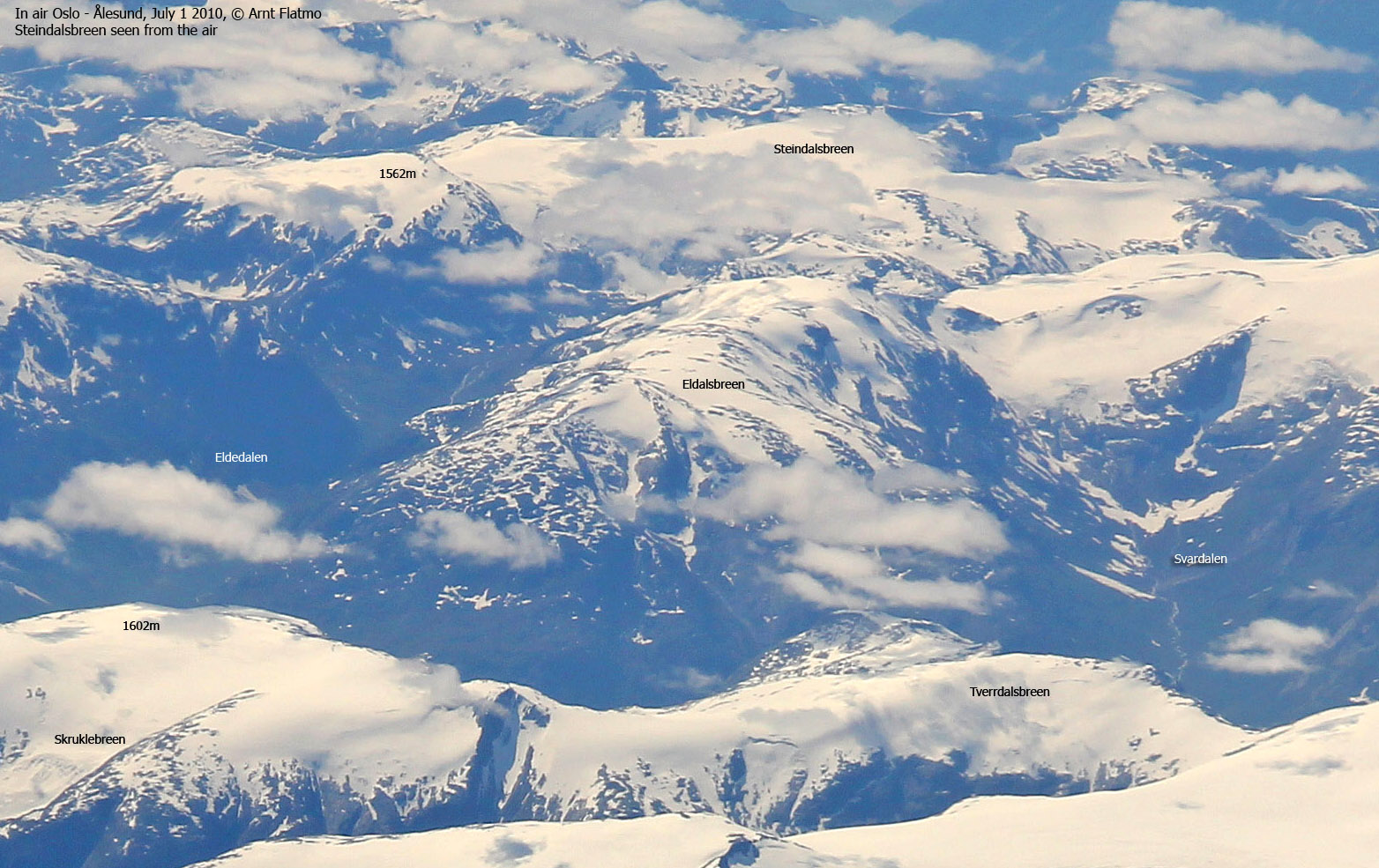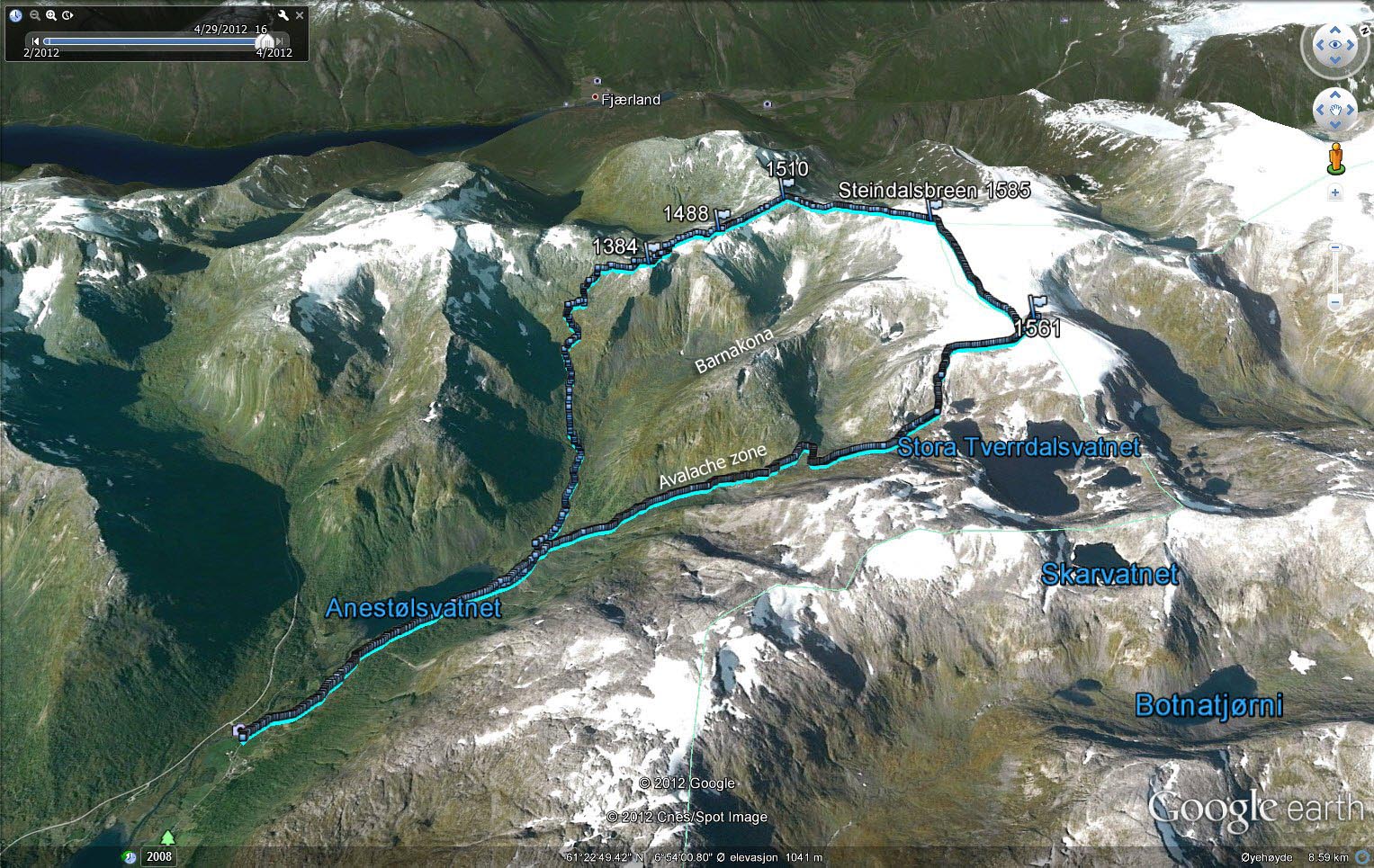
Norwegian Mountains, Sogn og Fjordane
Steindalsbreen (1585m)
Steindalsbreen E-1 (1562m)
Steindalseggi N (1512m) & S (1488m)
Sogndalseggi E (1384m)
| Fylke/Kommune: | Sogn og Fjordane county/Sogndal & Luster municipality | ||||||||||
| Maps: | 1317-I Fjærland (Statens Kartverk, Norge 1:50 000) | ||||||||||
| Primary factor: |
Steindalsbreen: 275m Steindalsbreen E-1: 92m Steindalseggi N: 122m Steindalseggi S: 58m Sogndalseggi E: 54m | ||||||||||
| Hiked: | Apr 2012 | ||||||||||
| See also: |
| ||||||||||
| See also : | Other Sogn og Fjordane mountains on westcoastpeaks.com |

Introduction
Steindalsbreen is an independent glacier located south of Jostedalsbreen, and should not be confused with Steindalsbreen in Lyngsalpane (Troms).
The glacier is relatively small, and is not among the 20 largest glaciers in Norway. The summit is shared between Sogndal and Luster municipalities and most of the glacier is within the Jostedalsbreen National Park border.
The easiest route runs from Sogndalsdalen, via Anestølen. This page will describe a magnificent round trip spring skiing route across Steindalsbreen and Steindalseggi. Note that the ascent route runs through Tverrdalen - infamous for its avalanches. This means you will have to know - and understand - the snow conditions before you go on this trip.
Steindalsbreen connects to Frudalshesten through Steindalseggi and Sogndalseggi. Steindalseggi has two tops - 1510m and 1488m. On this page, 1510 is referred to as 1512 as this is the height given on Økonomisk Kartverk - the map that this site primarily follows. Sogndalseggi has several tops but only the easternmost (E) top has a map height - 1384m. Based on what we could see from Sogndalseggi, it seems possible to ascend Frudalshesten this way.

Primary factor:
Steindalsbreen (Norge 1:50,000: 1585m, Økonomisk Kartverk: -, UTM 32 V 385218 6809548) has a primary factor of 175m towards the higher parent mountain Frudalshesten (1597m). The defining saddle (approx. 32 V 385139 6807426) is found just south of Skardvatnet. Ref. Norge 1:50,000 (20m contours), the saddle is within the range 1300-1320m, interpolated to 1310m.
Steindalsbreen E-1 (Norge 1:50,000: 1562m, Økonomisk Kartverk: -, UTM 32 V 388402 6810521) has a primary factor of 92m towards the higher parent mountain Steindalsbreen. The defining saddle (approx. 32 V 387984 6810228) is found between these two tops. Ref. Norge 1:50,000 (20m contours), the saddle is within the range 1460-1480m, interpolated to 1470m.
Steindalseggi N (Norge 1:50,000: 1510m, Økonomisk Kartverk: 1512,5m ~ 1512m, UTM 32 V 385218 6809548) has a primary factor of 122m towards the higher parent mountain Steindalsbreen. The defining saddle (approx. 32 V 385426 6809860) is found between these two tops. Ref. Norge 1:50,000 (20m contours), the saddle is within the range 1380-1400, interpolated to 1390m.
Steindalseggi S (Norge 1:50,000: 1488m, Økonomisk Kartverk: 1488,20m, UTM 32 V 385470 6808579) has a primary factor of 58m towards the higher parent mountain Steindalseggi N. The defining saddle (approx. 32 V 385319 6808979) is found between these two tops. Ref. Norge 1:50,000 (20m contours), the saddle is within the range 1420-1440, interpolated to 1430m.
Sogndalseggi E (Norge 1:50,000: 1384m, Økonomisk Kartverk: -, UTM 32 V 385539 6807694) has a primary factor of 54m towards the higher parent mountain Steindalseggi S. The defining saddle (approx. 32 V 385429 6807989) is found between these two tops. Ref. Norge 1:50,000 (20m contours), the saddle is within the range 1320-1340, interpolated to 1330m.

Google map
Google's interactive map. You can zoom, pan and click on the markers.
|
|
Trail descriptions
| This disclaimer is regarding all of the literature and instructional guides posted on the westcoastpeaks.com website. These instructions are guidelines only, and should not be used in lieu of common sense or judgment when attempting any of the actions involved or instructed. Westcoastpeaks nor myself will not be liable nor will it indemnify any form of compensation to anyone who has injured, harmed or even killed themselves or others while following any of the instructions written within the website. It should be noted by any persons willing to undertake any of the instructions provided that mountains offer varying levels of risk, regardless of size or incline. Risks to be considered are as follows but not limited to: wild animals, weather, the terrain, bad judgment, inappropriate or insufficient equipment, improper training or experience and of course, bad luck... |
|
Route 1: Anestølen - Steindalsbreen - Steindalseggi - Sogndalseggi - Anestølen (Spring)
|
|
This route description is valid per April 2012, and is based on snow that is suitable for skiing.
Access
(all distances are approx. distances)
The starting point for this route description is the village Sogndal - which has a local airport - Haukåsen.
Drive northwest up Sogndalsdalen (RV5), pass lake Dalavatnet and turn right towards Selseng / Anestølen (signposted) at the north end of the lake. If you end up in Frudalstunellen (tunnel), you've driven too far. Drive 250 meters (crossing a bridge along the way), then find parking at the beginning of the road to Anestølen (N61.34042 E6.92212). This road is not ploughed.
The route:

The 3km leg to Anestølen (N61.36568 E6.90645) is pure transport, along a toll road. Continue north up Tverrdalen, but only if you're sure that there is no avalanche hazard in this infamous valley. After a semi-steep pitch, the valley turns quite narrow - almost like a cleft. It could be wise to continue straight upwards instead of getting into this cleft. This is for two reasons; a) you could fall into the river and b) the climb up Tverrdalskyrkja is perhaps even steeper than the route up from the beginning of the cleft.
Once you're out of - and above Tverrdalen, aim for Nipa (1442m). The easiest route runs in a small valley east of Nipa. Once you reach the ridge from Nipa, follow it up to point 1562m (N61.41248 E6.90924 - marked by a cairn). This is a great viewpoint towards Steindalsbreen!
Descend the way you came until you find a good route down to the glacier. Ski 2km to the west and you'll reach the high point of Steindalsbreen (N61.41314 E6.87332)!
Continue southwest to Steindalsnipa and follow the ridge down - and up to Steindalseggi's north top (1512m - N61.40282 E6.85024). Make sure you enjoy the tremendous view towards the Fjærland mountains.
Next, proceed south to the south top (1488m - N61.39421 E6.85555). Descend south/southwest in the direction of Skardvatnet. At 1320 meters, turn east and ascend Sogndalseggi's east point (1384m - N61.38628 E6.85739). This is a fun ski-climb! Be aware of east-facing cornices!
The easiest (less steep) skiing route runs west of the marked summer path from Skardvatnet to Haugabotn. Again, you need to consider the avalanche hazard. But opposed to Tverrdalen, where the avalanches come from above, you are now in a position where you could release one. From Haugabotn, stay on the south side of the river. The crossing avalanches from Oksli are preferred over the birch forest at Tverrlii. Return to Anestølen on bridges.

Pictures and Trip reports:
 westcoastpeaks.com
westcoastpeaks.com
 Other Sogn og Fjordane mountains
Other Sogn og Fjordane mountains
 Other Norwegian mountains
Other Norwegian mountains


